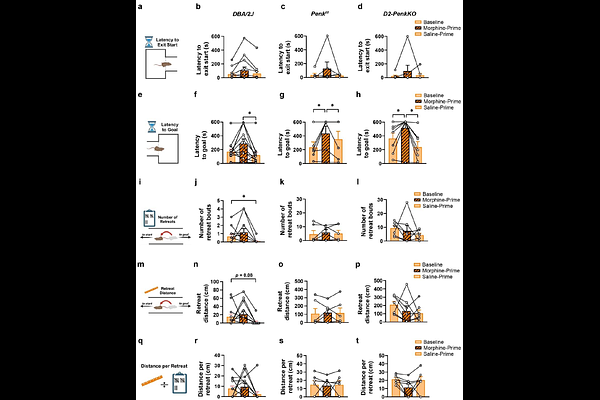C57 and DBA mouse strains express distinct cocaine avoidance phenotypes in an operant runway independent of differences in striatal dynorphin-enkephalin balance

C57 and DBA mouse strains express distinct cocaine avoidance phenotypes in an operant runway independent of differences in striatal dynorphin-enkephalin balance
Remmers, B. C.; Choi, I. B.; Matsumura, K.; Nicot, A.; Cox, S.; Dobbs, L. K.
AbstractRationale: Human self-report data and rodent models indicate cocaine can induce negative affect, which may impact future cocaine use severity. Despite this, understanding of the neurobiology driving cocaine avoidance is limited. Within the striatum, the opioid peptides enkephalin and dynorphin are associated with cocaine reward and aversion, respectively. Additionally, striatal dynorphin signaling resulting from stress or cocaine withdrawal acts as a negative reinforcer to increase cocaine seeking. Objectives: We validated the use of the cocaine self-administration runway in mice to measure the development of cocaine avoidance and tested whether mice with higher relative striatal dynorphin-to-enkephalin expression are resistant to developing cocaine avoidance. Methods: Cocaine avoidance in the self-administration runway was measured in two inbred mouse strains, C57BL/6J and DBA/2J, known to have opposite striatal dynorphin/enkephalin milieus, and in mice lacking enkephalin selectively from striatal medium spiny neurons (D2-PenkKO). Results: Both inbred strains developed cocaine avoidance, though they expressed it differently. Across training, DBA/2J mice increased their latency to self-administer cocaine, and C57BL/6J increased the number of retreats away from the cocaine-paired goal box. D2-PenkKOs developed similar cocaine avoidance compared to littermate controls. Conclusions: Mice develop avoidance to self-administer cocaine in the runway across a range of strains. Pre-existing strain differences in the striatal dynorphin/enkephalin milieu, however, do not appear to alter the development of cocaine avoidance, and striatal enkephalin is not necessary for the development of cocaine avoidance. This suggests higher relative striatal dynorphin does not facilitate cocaine seeking by mitigating cocaine avoidance.